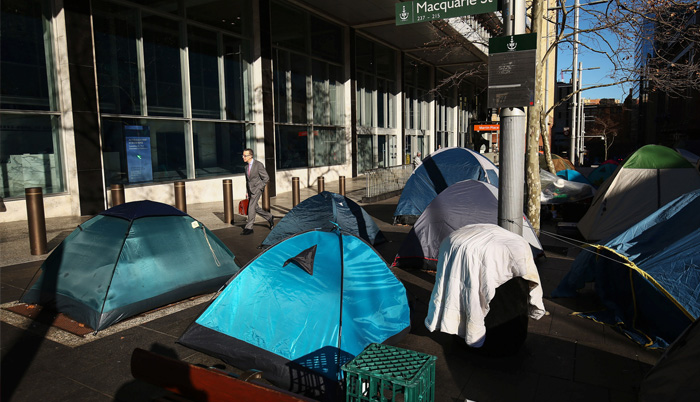![]() Home > World Business
Home > World Business
Housing Crisis Drives Homeless Australians To Central Bank's Door

Photographer: Brendon Thorne/Bloomberg
![]() August 2nd, 2017 | 08:14 AM |
August 2nd, 2017 | 08:14 AM | ![]() 1174 views
1174 views
AUSTRALIA
Majik used to sneak into Sydney’s botanical gardens before they were locked up at night so he could sleep safely. But as the cold weather closed in he joined other homeless people to shelter somewhere more central: outside the Reserve Bank of Australia.
“It’s impossible to afford accommodation in this city,” said Majik, 52, who has been living on the streets for three years and declined to give his surname. “We get some lovely people along here who give us a hand. They bring in food. They bring in clothing. They donate money.”
On the doorstep of Australia’s premier economic institution, a camp of about three-dozen tents and a kitchen has come to symbolize the housing affordability crisis gripping Sydney, where prices have soared 127 percent since 2009. Five years of rate cuts fueled a stratospheric housing boom in the city, where rental housing is now out of reach for 99 percent of low-income households, according to a recent report.
The camp outside the RBA’s Martin Place headquarters started late last year as a “safe space” for homeless women who feared for their safety and has since become a landing point for people down on their luck. Campers are being supported by local cafes, cooking and donations from church groups and assistance from passers by, according to organizers.
"The food is awesome," said a smiling Blake Metcalfe, who first stayed in the camp for a night after running out of cash. Recently out of jail, he’s now volunteering at the camp after the housing department found him somewhere to live. Accommodation costs are the key problem for the inhabitants, he said.
“It’s just crazy. The rent is just crazy,” said 40-year old Metcalfe, noting a 1-bedroom unit can cost A$600 ($480) a week before water and power costs. “Most wages are only A$700-A$800 a week. Prices are just astronomical.”
Inequality Row
The housing crisis is playing out against the backdrop of a rising debate about inequality in Australia. The opposition Labor party wants to crack down on tax breaks for the wealthy to help bridge what it says is a widening gap between rich and poor. The government, in contrast, insists there’s been no worsening in equality, and says the best way to help the country is to encourage economic growth, not pile on taxes.
The subject is sensitive in a nation that runs a comprehensive and expensive social safety net and has always prided itself on its egalitarian ways. The debate reached a crescendo last month when central bank Governor Philip Lowe was dragged into it.
The RBA chief acknowledged inequality had gone up. It increased “quite a lot” during the 1980s and 1990s when the economy was deregulated, he said after a speech last week, “and it’s risen a little bit just recently.” The real change, Lowe said, has been in wealth inequality, which has become “more pronounced” due to big gains in asset prices.
These have been fueled by an RBA easing cycle that began in late 2011 and culminated in interest rates being cut to a record-low 1.5 percent in August last year. Indeed, the surge in east coast housing prices is now seen by central bank watchers as a constraint on policy, restricting room to lower borrowing costs for fear of fueling additional gains.
The camp was originally located opposite the RBA at a building site with a large awning that protected the homeless from the weather. But the Sydney council deemed their proximity to the site dangerous, so they were forced to move further across to the forecourt of the RBA -- an irony given its role in unleashing the city’s housing boom.
“Sydney’s problem is a chronic shortage of affordable housing,” says Lanz Priestly, who formed the original camp in December and has worked with the homeless for decades. Priestly, in his 70s, was approached by 17 women in December after a spate of attempted rapes.
“When you hear that, you understand that this is a serious problem and you have to act immediately,” he said. “People were waking up to have their meager possessions stolen or some guy giving them a kicking because he was drunk. So the city needed a safe space for rough sleepers.”
Since then, he says, more than 450 people have passed through the camp as residents and he’s found housing for 212, which doesn’t include accommodation organized by the housing department. The camp, which has its own Facebook page, is not just for people staying in the tents, Priestly said. “Some people are paying 80 percent to 90 percent of their income on rent and literally have no cash left for food,” he said. “So we help them out.”
Sydney has had a visible homeless problem for some time. The general perception has been they were mainly mentally ill people or possibly drug addicts. But Priestly says the mentally ill only comprise a portion of the Martin Place camp, noting the homeless can come from many walks of life, mainly just people down on their luck.
Majik, who only moved to the Martin Place camp last week, concurs.
“It can happen to any one,” he said. “You just don’t know what’s around the corner.”
Source:
courtesy of BLOOMBERG
by Michael Heath
If you have any stories or news that you would like to share with the global online community, please feel free to share it with us by contacting us directly at [email protected]